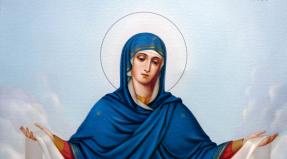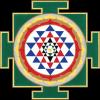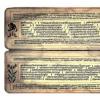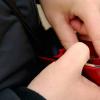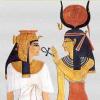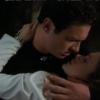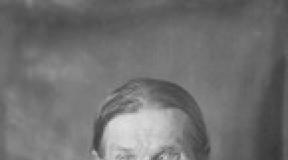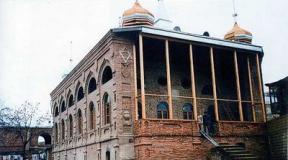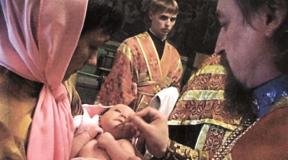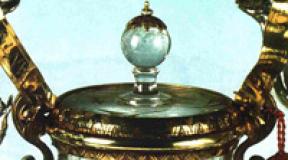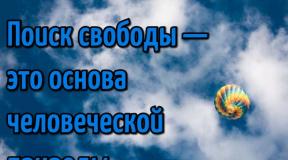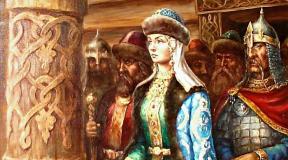The monastery in which the largest armed uprising took place. Participants in the uprising
The religious and political movement of the 17th century, as a result of which there was a separation from the Russian Orthodox Church of some of the believers who did not accept the reforms of Patriarch Nikon, was called a split.
Also, at the service, instead of singing "Hallelujah" twice, it was ordered to sing three times. Instead of going around the temple during baptism and wedding in the sun, going around the sun was introduced. Instead of seven prosphora at the liturgy, they began to serve at five. Instead of an eight-pointed cross, they began to use a four-pointed and six-pointed. By analogy with the Greek texts, instead of the name of Christ Jesus in newly printed books, the patriarch ordered Jesus to be written. In the eighth term of the Creed ("In the Holy Spirit of the True Lord"), I removed the word "true".
The innovations were approved by the church councils of 1654-1655. During 1653-1656, revised or newly translated liturgical books were published at the Printing House.
The discontent of the population was caused by violent measures, with the help of which Patriarch Nikon introduced new books and rituals into everyday life. The first for the "old faith", against the reforms and actions of the patriarch, were some members of the Circle of devotees of piety. Protopopes Avvakum and Daniel gave the king a note in defense of two fingers and bows during divine services and prayers. Then they began to argue that the introduction of corrections according to Greek patterns defiles the true faith, since the Greek Church has departed from "ancient piety", and its books are printed in the printing houses of Catholics. Ivan Neronov opposed the strengthening of the patriarch's power and for the democratization of church government. The clash between Nikon and the defenders of the "old faith" took sharp forms. Avvakum, Ivan Neronov and other opponents of the reforms were severely persecuted. The speeches of the defenders of the "old faith" received support in various strata of Russian society, from individual representatives of the highest secular nobility to the peasants. Among the masses, the sermons of the schismatics about the coming of the "end times", about the accession of the Antichrist, to whom the tsar, the patriarch and all the authorities had allegedly already bowed, found a lively response and carried out his will.
The Great Moscow Cathedral of 1667 anathematized (excommunicated) those who, after repeated admonitions, refused to accept new rites and newly printed books, and also continued to scold the church, accusing it of heresy. The council also stripped Nikon of his patriarchal dignity. The deposed patriarch was sent into captivity - first to Ferapontov, and then to Kirillo Belozersky monastery.
Carried away by the preaching of the schismatics, many townspeople, especially peasants, fled to the deep forests of the Volga region and the North, to the southern outskirts of the Russian state and abroad, and founded their communities there.
From 1667 to 1676, the country was engulfed in riots in the capital and on the outskirts. Then, in 1682, the streltsy riots began, in which the schismatics played an important role. The schismatics attacked monasteries, robbed monks, and seized churches.
A terrible consequence of the split was the burning - mass self-immolation. The earliest information about them dates back to 1672, when 2,700 people committed self-immolation in the Paleostrovsky monastery. From 1676 to 1685, according to documented information, about 20,000 people died. Self-immolations continued in the 18th century, and some cases - at the end of the 19th century.
The main result of the split was church division with the formation of a special branch of Orthodoxy - the Old Believers. By the end of the 17th - the beginning of the 18th century, there were various currents of the Old Believers, which received the names of "talk" and "agreement". The Old Believers were divided into clergy and non-priesthood. Popovtsy recognized the need for the clergy and all church sacraments, they were settled in the Kerzhensky forests (now the territory of the Nizhny Novgorod region), the regions of Starodubye (now the Chernigov region, Ukraine), the Kuban (Krasnodar region), the Don River.
Bespopovtsy lived in the north of the state. After the death of the pre-schismatic priests, they rejected the priests of the new ordination, therefore they began to be called bespopovtsy. The sacraments of baptism and penance and all church services, except for the liturgy, were performed by selected lay people.
Patriarch Nikon had nothing to do with the persecution of the Old Believers - from 1658 until his death in 1681, he was first in voluntary, and then in forced exile.
At the end of the 18th century, the schismatics themselves began to make attempts to get closer to the church. On October 27, 1800 in Russia, by the decree of Emperor Paul, unity of faith was established as a form of reunification of the Old Believers with the Orthodox Church.
Old Believers were allowed to serve according to old books and observe old rituals, among which the greatest importance was attached to two fingers, but the divine services and services were performed by Orthodox clergy.
In July 1856, by decree of Emperor Alexander II, the police sealed the altars of the Pokrovsky and Rozhdestvensky cathedrals of the Old Believer's Rogozhsky cemetery in Moscow. The reason was denunciations that liturgies were solemnly celebrated in churches, "seducing" the believers of the Synodal Church. Divine services were held in private prayer houses, in the houses of the capital's merchants and manufacturers.
On April 16, 1905, on the eve of Easter, a telegram from Nicholas II arrived in Moscow, allowing "to print the altars of the Old Believer chapels of the Rogozhsky cemetery." The next day, April 17, the imperial "Decree on Tolerance" was promulgated, which guaranteed freedom of religion for the Old Believers.
In 1929, the Patriarchal Holy Synod formulated three decrees:
- "On the recognition of old Russian rituals as salutary, as well as new rites, and equal to them";
- "On rejection and imputation, as if not former, condemnatory expressions related to the old rituals, and especially to the two-fingered";
- "On the abolition of the oaths of the Moscow Cathedral of 1656 and the Great Moscow Cathedral of 1667, imposed by them on the old Russian rituals and on the Orthodox believing Christians adhering to them, and to consider these oaths, as if they had never been."
The Local Council of 1971 approved three resolutions of the Synod of 1929.
On January 12, 2013, in the Assumption Cathedral of the Moscow Kremlin, with the blessing of His Holiness Patriarch Kirill, the first liturgy after the schism was performed according to the ancient order.
The material was prepared on the basis of information from open sourcesin
Representatives of various social strata took part: the elders of the monastery who opposed the reformational innovations, ordinary monks who fought against the growing power of the tsar and the patriarch, novices and monastery workers, alien dependent people, dissatisfied with the monastic order and the growing social oppression. The number of participants in the uprising was about 450-500 people.
The first stage of the confrontation between the Moscow authorities and the brethren of the Solovetsky Monastery is attributed to 1657. The monastery at that time was one of the richest and economically independent, due to its remoteness from the center and the wealth of natural resources.
In the "newly corrected liturgical books" brought to the monastery, the Solovites discovered "godly heresies and crafty innovations," which the monastic theologians refused to accept. From 1663 to 1668, 9 petitions and many letters were drawn up and sent to the king's name, using specific examples to prove the justice of the old faith. These letters also emphasized the intransigence of the Solovetsky monastic brethren in the struggle against the new faith.
The second stage began on June 22, 1668, when the first squad of archers was sent to pacify the monks. A passive blockade of the monastery began. In response to the blockade, the monks began an uprising under the slogan of the struggle "for the old faith" and took up defenses around the fortress. The rebels were helped and sympathized by peasants, workers and aliens, fugitive archers, and later participants in the peasant war that broke out under the leadership of Stepan Razin. In the early years, the Moscow government could not send significant forces to suppress the uprising due to other peasant unrest. However, the blockade continued, and the leadership of the monastery, as well as a significant part of the monks (monks who accepted the schema) came out for negotiations with the tsarist governors. The laity and newcomers refused to compromise and demanded from the monks "to put aside their prayer for the great sovereign." The negotiations, which were conducted with the rebels for 4 years, did not lead to anything. As a result, in 1674 Alexei Mikhailovich increased the army besieging the fortress, appointed Ivan Meshcherinov as the new governor, and gave him the order to “eradicate the rebellion soon”.
At the third stage of the struggle between the besieged and the streltsy army, numerous attempts were made to storm the fortress, which for a long time ended in vain. Despite the large number (up to 1 thousand people) of the archers, thrown to capture the recalcitrant and the presence of firearms, the fortress did not surrender. During the siege, the idea of \u200b\u200b"defending the old faith" was replaced by a denial of royal power and centralized church government. (“We do not need any decree from the great sovereign and we do not serve either in the new or in the old way, we do it in our own way”). In the monastery they stopped confessing, taking communion, recognizing priests, they began to involve all the monastery elders in the work - "in the barn, and in the cookery, and in the mukoseny." Attacks were organized against the troops besieging the monastery. Hegumen Nikandr specially sprinkled the cannons of those besieged with holy water. The resulting damage to the fortress wall, formed after continuous shelling, was quickly eliminated by the monks.
The confrontation ended unexpectedly in January 1676, when a defector, the monk Theoktista, probably seduced by some promises, pointed the archers to a secret underground passage in one of the towers. A small detachment of archers entered the monastery and opened the gates to the besiegers.
The assault was followed by a brutal massacre of the besieged (January 1676), which marked the final stage of the struggle. Of the 500 defenders of the fortress, only 60 survived, but they were soon executed. Only a few were saved; they were sent to other monasteries. The Solovetsky Monastery was weakened by repressions for many years. The “forgiveness” of the disgraced monastery was evidenced by the visit to the monastery by Peter I almost 20 years after the events described. However, the monastery regained its significance only in the late 18th and 19th centuries.
The Solovetsky uprising is one of the most notable protests against attempts to quickly reform religious life during the time of the "quietest tsar" Alexei Mikhailovich. Texts of numerous lists Tales and stories about the fathers and sufferers of the Solovetsky the self-taught writer of the Old Believer Semyon Denisov, who spoke about the atrocities and repressions of the tsarist pacifiers, were common throughout Russia. Perseverance in the faith and the martyrdom of the "Solovetsky elders" created an aura of martyrdom around them. Songs were composed about the Solovetsky defenders. There was even a legend among the people that as punishment for these atrocities, Alexei Mikhailovich was struck by a terrible disease and died covered with "pus and scabs."
Lev Pushkarev
Discontent start
“By the middle of the 17th century. The Solovetsky Monastery has become one of the richest and most independent Christian monasteries in Russia. Located on the islands of the White Sea, surrounded by a strong stone wall, equipped with a large number of military supplies and having a strong streltsy garrison, the monastery was an invulnerable frontier fortress, covering the entrance to the Arkhangelsk port. Due to its remoteness from the center, it was weakly connected with the Moscow Patriarchate and the Novgorod Metropolitanate, to which it was once subordinate. On the vast territory that belonged to the monastery - the islands and the sea coast, there were large enterprises that brought a large income for those times. The monastery owned fishing, salt brews, mica workings, tanneries, potash factories. But the end of the century was marked by a major national demonstration. " [Sokolova]
“The Solovetsky uprising broke out on the crest of the popular uprisings of the 17th century. in the summer of 1648 there was an uprising in Moscow, then in Solvychegodsk, Veliky Ustyug, Kozlov, Voronezh, Kursk. In 1650 uprisings broke out in Pskov and Novgorod. In the early 60s, there was unrest over new copper money. These unrest were called "copper riots". The Solovetsky uprising of 1668-1676 was the end of all these unrest and the Peasant War led by Stepan Razin, but discontent in the monastery appeared much earlier.
Apparently, already in 1646, dissatisfaction with the government was felt in the monastery and its estates. On June 16, 1646, Abbot Ilya wrote to lead to the kissing of the cross by worldly people of different ranks, archers and peasants in the monastic estates. An oath form was soon sent from Moscow. The monastic pledged in it to faithfully serve the sovereign, to want good for him without any cunning, to inform about any osprey and conspiracy, to carry out military affairs without any treason, not to adhere to traitors, not to do anything arbitrarily, in bulk or by conspiracy, etc. From this it is clear that the danger of "osprey", conspiracies and betrayals was real.
The gradually accumulating discontent with Patriarch Nikon resulted in 1657 in the decisive refusal of the monastery, headed by its then Archimandrite Ilya, to accept newly printed liturgical books. The disobedience of the monastery took on various forms in the following years and was largely determined by pressure from below the lay people living in the monastery (primarily workers) and ordinary monks. The following years were filled with numerous events, during which the monastery, torn apart by internal contradictions, as a whole still refused to submit not only to the church authority of the patriarch, but also to the secular authority of the tsar. " [Likhachev 1 - 30]
In July – August 1666, at the behest of the Tsar and the Ecumenical Patriarchs, a "Council Command to Accept the newly corrected books and ranks" was sent to the Solovetsky Monastery. In response petitions, the Council, the brethren, the "baltsy" and the laity promised to submit to the imperial power in everything, but they only asked "not to change the faith." But disagreements became more and more noticeable in the monastery: the bulk of the brethren, opposing Nikon's innovations, expressed their dissatisfaction with the monastic administration, demanding the elimination of Hegumen Bartholomew. Relying on servicemen and black people, they expressed more and more radical ideas of resistance. At the same time, a small group of monastic brethren stood out, which was inclined to compromise with the authorities and accept church reform.
In October 1666, the monastery refused to accept the archimandrite of the Yaroslavl Spassky monastery Sergius sent by the Moscow Cathedral to search for the Solovetsky monks in the petition. In February 1667 in the Sumy prison, one hundred and fifty kilometers from the monastery, a special investigator, A. S. Khitrovo, arrived for the "detective case". The summoned elders and monastery servants did not appear for interrogation. In response to disobedience, on December 27, 1667, a royal decree was issued, which ordered that “the Solovetsky Monastery patrimonial villages, and villages, and salt and all kinds of trades, both in Moscow and in the towns of courtyards with all sorts of factories and reserves, and to write off salt to us , the great sovereign, and from those villages, and from the villages, and from all kinds of money, and all kinds of grain supplies, and salt, and all purchases from Moscow and from cities to that monastery were not ordered. " [Sokolova]
Participants in the uprising
“The main driving force of the Solovetsky uprising at both stages of the armed struggle was not the monks with their conservative ideology, but the peasants and Balts - temporary inhabitants of the island who did not have a monastic rank. Among the Balts there was a privileged group that adjoined the brethren and the cathedral elite. These are the servants of the archimandrite and the cathedral elders (servants) and the lower composition of the clergy: sexton sexton, kliroshan (servicemen). The bulk of the Balti were workers and working people who served the inner monastic and patrimonial economy and were exploited by the spiritual feudal lord. Among the workers who worked "for hire" and "on a promise", that is, for free, who made a vow "to atone for their sins with Godly labor and earn forgiveness", there were many "walking", runaway people: peasants, townspeople, archers, Cossacks, yaryzheks. It was they who made up the main core of the rebels.
The exiles and the disgraced, who numbered up to 40 people on the island, turned out to be a good "combustible material".
In addition to the working people, but under his influence and pressure, a part of the rank and file brotherhood joined the uprising. This is not surprising, for the black elders by their origin were "all peasant children" or people from the townships. However, as the uprising deepened, the monks, frightened by the decisiveness of the people, broke with the uprising.
An important reserve of the rebellious monastic masses was the Pomor peasantry, working in the usol, in mica and other industries, which came under the protection of the walls of the Solovetsky Kremlin. [Frumenkov 3 - 67]
“Typical in this respect is the testimony of Elder Prokhor:“ There are only three hundred brothers in the monastery, and there are more than four hundred Belts, they locked themselves in the monastery and sat down to die, but the buildings do not want any images. And they began to stand for theft and capitonism, and not for faith. And in the monastery de Razinovshchina came many Cherni and Beltsy Kapitons from lower cities, those de their thieves both from the church and from the spiritual fathers excommunicated. Yes, they also had Moscow runaway riflemen and Don Cossacks and runaway boyar lackeys and rogue state foreigners in the monastery ... and all evil gathered here in the monastery. " [Likhachev 1 - 30]
“There were over 700 people in the insurgent monastery, including over 400 resolute supporters of the struggle against the government by the method of peasant war. The insurgents had at their disposal 990 cannons, placed on the towers and the fence, 900 poods of gunpowder, a large number of hand firearms and bladed weapons, as well as protective equipment. " [Frumenkov 2 - 21]
The stages of the uprising
“The uprising in the Solovetsky Monastery can be divided into two stages. At the first stage of the armed struggle (1668-1671), laity and monks came out under the banner of defending the "old faith" against Nikon's innovations. The monastery at that time was one of the richest and most economically independent, due to its remoteness from the center and richness of natural resources.
In the "newly corrected liturgical books" brought to the monastery, the Solovites discovered "godly heresies and crafty innovations," which the monastic theologians refused to accept. The struggle of the exploited masses with the government and the church, like many actions of the Middle Ages, took on a religious shell, although in fact, under the slogan of protecting the "old faith", the democratic strata of the population fought against the state and monastic feudal-serf oppression. Lenin drew attention to this feature of the revolutionary actions of the peasantry crushed by the darkness. He wrote that "... the appearance of a political protest under a religious shell is a phenomenon characteristic of all peoples at a certain stage of their development, and not of Russia alone" (vol. 4, p. 228). " [Frumenkov 2 - 21]
“Apparently, initially Tsar Alexei Mikhailovich hoped to starve and intimidate the monastery, blocking the delivery of food and other necessary supplies. But the blockade dragged on, and in the Volga region and in the south of Russia a peasant war broke out under the leadership of S. T. Razin. [Sokolova]
“In 1668, the tsar ordered to besiege the monastery. An armed struggle between the Solovites and government troops began. The beginning of the Solovetsky uprising coincided with the peasant war that broke out in the Volga region under the leadership of ST Razin. [Frumenkov 2 - 21]
“The government, not without reason, feared that its actions would stir up the entire Pomorie region and turn the region into a continuous area of \u200b\u200bpopular uprising. Therefore, the first years of the siege of the rebellious monastery were carried on sluggishly and intermittently. In the summer months, the tsarist troops landed on the Solovetsky Islands, tried to block them and interrupt the connection of the monastery with the mainland, and in the winter they went ashore to the Sumy prison, and the Dvinsky and Kholmogory archers, who were part of the government army, were dismissed for this time to their homes.
The transition to open military operations to the extreme exacerbated social contradictions in the camp of the rebels and accelerated the demarcation of the fighting forces. It was finally completed under the influence of the Razin people, who began to arrive at the monastery in the fall of 1671. " [Frumenkov 3 - 69]
“The participants in the peasant war of 1667-1671 who joined the rebellious mass. took the initiative in the defense of the monastery into their own hands and intensified the Solovetsky uprising.
The fugitive boyar servant Isachko Voronin, the Kemsman Samko Vasilyev, the Razin atamans F. Kozhevnikov and I. Sarafanov came to the leadership of the uprising. The second stage of the uprising began (1671 - 1676), in which religious issues receded into the background and the idea of \u200b\u200bthe struggle for the "old faith" ceased to be the banner of the movement. The uprising takes on a pronounced anti-feudal and anti-government character, it becomes a continuation of the peasant war led by S. T. Razin. The far North of Russia became the last hotbed of the peasant war. " [Frumenkov 2 - 22]
“In the“ questioning speeches ”of the natives of the monastery it is reported that the leaders of the uprising and many of its participants“ do not go to the church of God, and do not come to confession to the spiritual fathers, and the priests are cursed and called heretics and apostates. ” Those who reproached them for the fall were answered: "We will live without priests." Newly corrected liturgical books were burned, tore, drowned in the sea. The rebels "put aside" the pilgrimage for the great sovereign and his family and did not want to hear more about it, and some of the rebels said about the tsar "such words that not only to write, but also to think is scary." [Frumenkov 3 - 70]
“Such actions finally scared off the uprising of the monks. For the most part, they break with the movement and try to distract the working people from the armed struggle, take the path of treason and organize conspiracies against the uprising and its leaders. Only the fanatical supporter of the “old faith”, the exiled Archimandrite Nikanor, with a handful of adherents, until the end of the uprising, hoped with the help of arms to cancel Nikon's reform. The leaders of the people decisively dealt with the reactionary monks who were engaged in subversive activities: they imprisoned some, and expelled others from the walls of the fortress.
The population of Pomorie expressed sympathy for the rebellious monastery and provided it with constant support with people and food. Thanks to this help, the rebels not only successfully repelled the attacks of the besiegers, but also made bold forays themselves, which demoralized the government archers and caused them great damage. " [Frumenkov 2 - 22]
“The entire civilian population of Solovki was armed and organized in a military manner: divided into tens and hundreds with the appropriate commanders at the head. The besieged significantly fortified the island. They cleared the forest around the dock so that no ship could come to the shore unnoticed and fell into the zone of fire from the fortress guns. The low section of the wall between the Nikolsky Gate and the Kvasoparennaya Tower was raised with wooden terraces to the height of other sections of the fence, a low Kvasoparennaya tower was built on, and a wooden platform (roll) was arranged on the Drying Chamber for installing the guns. The courtyards around the monastery, allowing the enemy to covertly approach the Kremlin and complicating the defense of the city, were burned. It became "smooth and even" around the monastery. Planks with hammered nails were placed in places of possible attack and fixed. A guard service was organized. A guard of 30 people was stationed in shifts at each tower, the gates were guarded by a team of 20 people. The approaches to the monastery fence were also significantly strengthened. In front of the Nikolskaya tower, where most often it was necessary to repulse the attacks of the tsarist archers, they dug trenches and surrounded them with an earthen rampart. Here they installed guns and made loopholes. All this testified to the good military training of the leaders of the uprising, their familiarity with the technique of defensive structures. " [Frumenkov 3 - 71]
“After the suppression of the peasant war under the leadership of ST Razin, the government proceeded to take decisive action against the Solovetsky uprising.
In the spring of 1674, a new voivode, Ivan Mescherinov, arrived at Solovki. Up to 1000 riflemen, artillery entered under his command. In the fall of 1675, he sent a report to Tsar Alexei Mikhailovich outlining the plans for the siege. The archers dug under three towers: White, Nikolskaya and Kvasoparennaya. On December 23, 1675, they attacked from three sides: where there were tunnels, and also from the side of the Holy Gates and the Herring (Arsenal) Tower. “The rebels did not sit idly by. Under the leadership of the fugitive Don Cossacks, experienced in military affairs, Peter Zapruda and Grigory Krivonog, fortifications were erected in the monastery.
In the summer and autumn months of 1674 and 1675. hot battles unfolded under the walls of the monastery, in which both sides suffered heavy losses. " [Frumenkov 2 - 23]
Fall of the monastery
“Due to the brutal blockade and continuous fighting, the number of defenders of the monastery also gradually decreased, the stocks of military materials and foodstuffs were depleted, although the fortress could still defend itself for a long time. On the eve of his fall, the monastery had, according to the defectors, grain reserves for seven, according to other sources - for ten years, cow butter for two years. Only vegetables and fresh foods were lacking, which led to an outbreak of scurvy. 33 people died of scurvy and wounds. " [Frumenkov 3 - 73]
“The Solovetsky Monastery was not taken by storm. He was betrayed by the traitorous monks. The defector monk Theoktist led a detachment of archers into the monastery by secret passage. Through the tower gates they opened, the main forces of I. Meshcherinov poured into the fortress. The rebels were taken by surprise. The massacre began. Almost all the defenders of the monastery perished in a short battle. Only 60 people survived. 28 of them were executed immediately, including Samko Vasiliev, the rest - later. " [Frumenkov 2 -23]
“The reprisals against the rebels were extremely harsh. According to the traitor Feoktist, Meshcherinov "hanged some of the thieves, and many, dragging the monastery to the lip (that is, the bay), froze." Those executed on the Babya Luda Island were buried at the entrance to the Bay of Prosperity. The corpses were not buried: they were stoned. " [Likhachev 1 - 32]
“The defeat of the Solovetsky Monastery took place in January 1676. This was the second blow to the popular movement after the defeat of the peasant war of S. T. Razin. Soon after the suppression of the uprising, the government sent reliable monks from other monasteries to Solovki, ready to pray for the tsar and the reformed church.
The Solovetsky uprising of 1668-1676 was the largest anti-serf movement of the 17th century after the peasant war under the leadership of ST Razin. "
Description of the presentation by individual slides:
1 slide
Slide Description:
Popular movements of the 17th century. "The rebellious age" Prepared by the teacher of history and social studies of the FGOU secondary school No. 4 of the Ministry of Defense of the Russian Federation Latypova O.Sh.
2 slide
Slide Description:
To characterize the difficult internal situation in Russia in the 17th century, to present the cause-and-effect relationships of popular performances in the 17th century, to determine the characteristics of popular performances. LESSON OBJECTIVES: LESSON OUTLINE: Reasons for popular performances Salt revolt Copper revolt Stepan Razin's revolt Old Believers' speeches Chronological table "17th century -" rebellious century "
3 slide
Slide Description:
REASONS FOR PEOPLE'S RACES The main reasons for popular rallies were: enslavement of the peasants and the growth of feudal duties; increased tax oppression, the conduct of almost continuous wars, increased order red tape; attempts to limit Cossack freedom; church schism and reprisals against the Old Believers. The main tax burden falls on the shoulders of the people, who are protesting by riots. Moscow 17th century
4 slide
Slide Description:
REASONS OF FOLK PERFORMANCES During the reign of Alexei Mikhailovich (Quietest), the country was shaken by popular uprisings, which were remembered by both contemporaries and descendants. The 17th century was nicknamed "Rebel". The most famous social performances: Salt, Plague and Copper riots, the peasant war led by Stepan Razin and the movement of Old Believers "Rebellion Age"
5 slide
Slide Description:
The reason was the attempt of the boyar B.I. Morozov to introduce an additional tax on the sale and purchase of salt in Since salt was the most important consumer product, its rise in price hit the population of the SALY Riot On June 1, 1648, Tsar Alexei Mikhailovich was returning from a pilgrimage from the Trinity-Sergius Monastery to the Kremlin. A crowd of Muscovites tried to give him a petition, but the archers dispersed the crowd. Ernest Lissner "Salt Riot"
6 slide
Slide Description:
Salt revolt On June 2, 1648, the townspeople burst into the Kremlin, but failed to hand over the petition to the tsar - the boyars tore up the petition and threw it among the people. On the same day, the dissatisfied destroyed the houses of the hated boyars. On June 4, 1648, Leonty Pleshcheev, the chief of the Zemsky Prikaz, was torn to pieces on Red Square. The tsar managed to save only his "uncle" BI Morozov, urgently sending him into exile in the Kirillo-Belozersky monastery. ... B. Kustodiev. "Revolt of the townspeople in the 17th century"
7 slide
Slide Description:
Salt revolt Results and results of the salt revolt The king made concessions to the rebels. The perpetrators of the corruption policy were handed over to the crowd. Later, the Zemsky Sobor was convened in 1649, at which a unified procedure for legal proceedings was introduced, most of the taxes were abolished. The shooters who participated in the riot were not punished, but on the contrary were left in the service and their salaries were raised. The leaders and the most active participants were executed. Torture on the rack. Old engraving.
8 slide
Slide Description:
Copper revolt - a revolt against the increase in taxes and the issue of copper coins that are depreciating in comparison with silver coins since 1654, which took place in Moscow on July 25, 1662. It was prescribed to trade with copper money, and pay taxes in silver. "The peasant, seeing such poor money made at one time ... did not go to the cities to carry hay and firewood and food supplies," and "great poverty began throughout the country ... and in all sorts of food a great dear ... from thieves from copper money ". From the chronicle COPPER Riot Copper penny
9 slide
Slide Description:
Copper Riot In August 1662, at the Lubyanka, sheets were found with accusations against a number of wealthy boyars who were accused of secret relations with Poland. Although the accusations had no basis, the crowd rushed to smash their houses, and then went to the king in the village. Kolomenskoye Ernest. Lissner. "The uprising in Kolomenskoye in 1662"
10 slide
Slide Description:
The king entered into negotiations with the rebels and promised to abolish the copper money. Believing the tsar, the townspeople headed back to Moscow. However, on the way they met a new crowd of many thousands, and the procession to Kolomenskoye resumed. In the meantime, the king managed to gather troops. The unarmed crowd was put to flight by force of arms. Copper Riot
11 slide
Slide Description:
Copper Riot “And that same day, about 150 people were hanged near that village, and the rest were all ordered by a decree, tortured and burned, and, in search of guilt, they cut off the hands and feet of both hands and feet, and beat others with a whip, and put them on on the face on the right side there are signs that set the iron on red, and put on that iron "beeches", that is, a rebel, so that he would be recognized forever; and punishing them, they sent everyone to distant cities, to Kazan, and to Astarakhan, and to Terki, and to Siberia, for eternal life ... and another thief of the same day, in the night, issued a decree, tying his hands back to courts, sunk the river in Moscow "
12 slide
Slide Description:
Results and Results of the Copper Riot The result of the copper riot was the gradual abolition of the copper coin. In 1663, the copper courtyards in Novgorod and Pskov were closed, and the minting of silver coins resumed. Copper money was completely withdrawn from circulation and melted into other useful copper objects. Copper Riot Palekh miniature. "Copper Riot"
13 slide
Slide Description:
The largest popular uprising of the 17th century was the uprising of the Cossacks and peasants under the leadership of S. T. THE UPRISING OF STEPAN RAZIN Razin, a native of the Don village of Zimoveyskaya. Peasants, townspeople, everyone who wanted to become free fled to the Don from serf bondage. ". In the Cossack environment, there was an unwritten law - "there is no extradition from the Don." The source of income of the Cossacks was the campaigns "for the zipuns", ie. for the loot Stepan Razin
14 slide
Slide Description:
Stepan Razin himself was an evil and intelligent man, experienced and cunning, had a penchant for adventures, military dexterity and the qualities of a ruthless chieftain. THE RISE OF STEPAN RAZIN B. M. Kustodiev. Stepan Razin
15 slide
Slide Description:
During the first campaign (1667-1669), which is called the "campaign for the zipuns," Razin's detachment blocked the Volga, the main economic artery of southern Russia, and seized the merchant ships of Russian and Persian merchants. S. Razin captured Yaitsky town, defeated the Persian fleet. Having received rich booty, in the summer of 1669 Razin returned to the Don and settled with his detachment in the Kagalnitsky town. Stepan Razin's hike for "zipuns" STEPAN RAZIN UPRISING
16 slide
Slide Description:
THE RISE OF STEPAN RAZIN Thousands of disadvantaged people began to come here from everywhere. Feeling the strength, Razin announced a campaign against Moscow, where he promised "to beat all the princes and boyars and all the nobility (nobility) of Russia."
17 slide
Slide Description:
Lovely letters from S. Razin “... by the decree of the great sovereign the tsar and the grand duke RISE OF STEPAN Razin Alexei Mikhailovich ... and according to the letter of Evo, the great sovereign, we went out, the great army of the Don, from the Don Don to him, the great sovereign, to serve nevo, the great sovereign, the princes did not become even from them, the traitors of the boyars. And we, the great army of the Don, stood for the house of the Most Holy Theotokos and for Eve, the great sovereign, and for all the rabble. »Cossack plows
18 slide
Slide Description:
19 slide
Slide Description:
Among the participants in the performance were Cossacks, Russian peasants, representatives of many peoples of the Volga region: Chuvash, Mari, Tatars, Mordovians. Most of them were attracted to Razin by the fact that he declared each participant in the performance a Cossack (that is, a free person). The total population of the insurgent lands was about 200 thousand people. STEPAN RAZIN UPRISING Territory covered by S. Razin's uprising.
20 slide
Slide Description:
In the spring of 1670, the second stage of Razin's performance began. The rebels captured Tsaritsyn on the move and approached the well-fortified Astrakhan, which surrendered without a fight. The success of the rebels served as a signal for the transition to the side of Razin of the population of many Volga cities: Saratov, Samara, Penza and others. In September 1670, the rebels laid siege to Simbirsk. STEPAN'S RAZIN UPRISING Razin's weapon.
21 slide
Slide Description:
THE UPRISING OF STEPAN RAZIN On 01.10.1670 a decisive battle began under the walls of Simbirsk. S. Razin fought in the thick of things, but his army could not resist, it fled. The wounded S. Razin was carried out of the battle. With his closest associates, he sailed down the Volga, hid on the Don. The forces of the rebels scattered, they suffered defeats. In Arzamas, about 11 thousand people were executed. Up to 100 thousand participants in the uprising were repressed. V. Surikov. Stepan Razin
22 slide
Slide Description:
THE RISE OF STEPAN RAZIN Fearing reprisals, wealthy Cossacks, led by the ataman Kornila Yakovlev, seized Razin and gave him over to Moscow. On June 6, 1670, after being tortured, Stepan Razin was quartered on Bolotnaya Square in Moscow. S. A. Kirillov "They're taking Razin!" S. A. Kirillov "Stepan Razin"
23 slide
Slide Description:
However, the uprising continued. Only a year later, in November 1671, the tsarist troops managed to occupy Astrakhan and completely suppress the uprising. The scale of the reprisals against the differences was enormous. In Arzamas alone, up to 11 thousand people were executed. In total, up to 100 thousand rebels were killed and tortured. The country has never known such reprisals. THE UPRISING OF STEPAN RAZIN Repression of the rebels
24 slide
Slide Description:
Results of the uprising. The rebels did not achieve the satisfaction of any of their goals: the tsar's power continued to be tightened, the Cossacks were for a long time pushed back from the government, and serfdom was not abolished. THE UPRISING OF STEPAN RAZIN Repression of the rebels
25 slide
Slide Description:
PERFORMANCES OF THE OLD BELIEVERS The Old Believers' movement united representatives of various social strata. The forms of protest were also varied: from self-immolation and starvation, refusal to recognize Nikon's reform, evasion of duties and insubordination to the authorities, to armed resistance to the tsarist governors. For peasants-Old Believers and townspeople, this was a form of social protest. V. Surikov "Boyarynya Morozova"
26 slide
“The main driving force behind the Solovetsky uprising at both stages of the armed struggle was not the monks with their conservative ideology, but the peasants and Balts - temporary inhabitants of the island who did not have a monastic rank. Among the Balts there was a privileged group that adjoined the brethren and the cathedral elite. These are the servants of the archimandrite and the cathedral elders (servants) and the lower composition of the clergy: sexton sexton, kliroshan (servicemen). The bulk of the Balti were workers and working people who served the inner monastic and patrimonial economy and were exploited by the spiritual feudal lord. Among the workers who worked "for hire" and "on a promise", that is, for free, who made a vow "to atone for their sins with Godly labor and earn forgiveness", there were many "walking", runaway people: peasants, townspeople, archers, Cossacks, yaryzheks. It was they who made up the main core of the rebels.
The exiles and the disgraced, who numbered up to 40 people on the island, turned out to be a good "combustible material".
In addition to the working people, but under his influence and pressure, a part of the rank and file brotherhood joined the uprising. This is not surprising, for the black elders by their origin were "all peasant children" or people from the townships. However, as the uprising deepened, the monks, frightened by the decisiveness of the people, broke with the uprising.
An important reserve of the rebellious monastic masses was the Pomor peasantry, working in the usol, in mica and other industries, which came under the protection of the walls of the Solovetsky Kremlin. [Frumenkov 3 - 67]
“Typical in this respect is the testimony of Elder Prokhor:“ There are only three hundred brothers in the monastery, and there are more than four hundred Belts, they locked themselves in the monastery and sat down to die, but the buildings do not want any images. And they began to stand for theft and capitonism, and not for faith. And in the monastery de Razinovshchina came many Cherni and Beltsy Kapitons from lower cities, those de their thieves both from the church and from the spiritual fathers were excommunicated. Yes, they also had Moscow runaway riflemen and Don Cossacks and runaway boyar lackeys and rogue state foreigners in the monastery ... and all evil gathered here in the monastery. " [Likhachev 1 - 30]
“There were over 700 people in the insurgent monastery, including over 400 resolute supporters of the struggle against the government by the method of peasant war. The insurgents had at their disposal 990 cannons, placed on the towers and the fence, 900 poods of gunpowder, a large number of hand firearms and bladed weapons, as well as protective equipment. " [Frumenkov 2 - 21]
The stages of the uprising
“The uprising in the Solovetsky Monastery can be divided into two stages. At the first stage of the armed struggle (1668-1671), laity and monks came out under the banner of defending the "old faith" against Nikon's innovations. The monastery at that time was one of the richest and most economically independent, due to its remoteness from the center and richness of natural resources.
In the "newly corrected liturgical books" brought to the monastery, the Solovites discovered "godly heresies and crafty innovations," which the monastic theologians refused to accept. The struggle of the exploited masses with the government and the church, like many actions of the Middle Ages, took on a religious shell, although in reality, under the slogan of protecting the "old faith", the democratic strata of the population fought against the state and monastic feudal-serf oppression. This feature of the revolutionary actions of the peasantry, crushed by the darkness, drew the attention of V.I. Lenin. He wrote that "... the appearance of a political protest under a religious shell is a phenomenon characteristic of all peoples at a certain stage of their development, and not of Russia alone" (vol. 4, p. 228). " [Frumenkov 2 - 21]
“Apparently, initially Tsar Alexei Mikhailovich hoped to starve and intimidate the monastery, blocking the delivery of food and other necessary supplies. But the blockade dragged on, and in the Volga region and in the south of Russia a peasant war broke out under the leadership of S. T. Razin. [Sokolova]
“In 1668, the tsar ordered to besiege the monastery. An armed struggle between the Solovites and government troops began. The beginning of the Solovetsky uprising coincided with the peasant war that broke out in the Volga region under the leadership of S.T. Razin. " [Frumenkov 2 - 21]
“The government, not without reason, feared that its actions would stir up the entire Pomorie region and turn the region into a continuous area of \u200b\u200bpopular uprising. Therefore, the first years of the siege of the rebellious monastery was carried out sluggishly and intermittently. In the summer months, the tsarist troops landed on the Solovetsky Islands, tried to block them and interrupt the connection of the monastery with the mainland, and in the winter they went ashore to the Sumy prison, and the Dvinsky and Kholmogory archers, who were part of the government army, were dismissed for this time to their homes.
The transition to open military operations to the extreme exacerbated social contradictions in the camp of the rebels and accelerated the demarcation of the fighting forces. It was finally completed under the influence of the Razin people, who began to arrive at the monastery in the fall of 1671. " [Frumenkov 3 - 69]
“The participants in the peasant war of 1667-1671 who joined the rebellious mass. took the initiative in the defense of the monastery into their own hands and intensified the Solovetsky uprising.
The fugitive boyar servant Isachko Voronin, the Kemsman Samko Vasilyev, the Razin atamans F. Kozhevnikov and I. Sarafanov came to the leadership of the uprising. The second stage of the uprising began (1671 - 1676), in which religious issues receded into the background and the idea of \u200b\u200bthe struggle for the "old faith" ceased to be the banner of the movement. The uprising takes on a pronounced anti-feudal and anti-government character, becomes a continuation of the peasant war led by S.T. Razin. The far North of Russia became the last hotbed of the peasant war. " [Frumenkov 2 - 22]
"In the" interrogative speeches "of the natives of the monastery it is reported that the leaders of the uprising and many of its participants" do not go to the church of God, and do not come to confession to the spiritual fathers, and the priests are cursed and called heretics and apostates. " Those who reproached them for the fall were answered: "We will live without priests." Newly corrected liturgical books were burned, tore, drowned in the sea. The rebels "put aside" the pilgrimage for the great sovereign and his family and did not want to hear more about it, while some of the rebels said about the tsar "such words that not only to write, but also to think is scary." [Frumenkov 3 - 70]
“Such actions finally scared off the uprising of the monks. For the most part, they break with the movement and try to distract the working people from the armed struggle, take the path of treason and organize conspiracies against the uprising and its leaders. Only the fanatical supporter of the “old faith”, the exiled Archimandrite Nikanor, with a handful of adherents, until the end of the uprising, hoped with the help of arms to cancel Nikon's reform. The leaders of the people decisively dealt with the reactionary monks who were engaged in subversive activities: they imprisoned some, and expelled others from the walls of the fortress.
The population of Pomorie expressed sympathy for the rebellious monastery and provided it with constant support with people and food. Thanks to this help, the rebels not only successfully repelled the attacks of the besiegers, but also made bold forays themselves, which demoralized the government archers and caused them great damage. " [Frumenkov 2 - 22]
“The entire civilian population of Solovki was armed and organized in a military manner: divided into tens and hundreds with the appropriate commanders at the head. The besieged significantly fortified the island. They cleared the forest around the dock so that no ship could come to the shore unnoticed and fell into the zone of fire from the fortress guns. The low section of the wall between the Nikolsky Gate and the Kvasoparennaya Tower was raised with wooden terraces to the height of other sections of the fence, a low Kvasoparennaya tower was built on, and a wooden platform (roll) was arranged on the Drying Chamber for installing the guns. The courtyards around the monastery, allowing the enemy to covertly approach the Kremlin and complicating the defense of the city, were burned. It became "smooth and even" around the monastery. Planks with hammered nails were placed in places of possible attack and fixed. A guard service was organized. A guard of 30 people was stationed in shifts at each tower, the gates were guarded by a team of 20 people. The approaches to the monastery fence were also significantly strengthened. In front of the Nikolskaya tower, where most often it was necessary to repulse the attacks of the tsarist archers, they dug trenches and surrounded them with an earthen rampart. Here they installed guns and made loopholes. All this testified to the good military training of the leaders of the uprising, their familiarity with the technique of defensive structures. " [Frumenkov 3 - 71]
“After the suppression of the peasant war led by S.T. Razin's government proceeded to take decisive action against the Solovetsky uprising.
In the spring of 1674, a new voivode, Ivan Mescherinov, arrived at Solovki. Up to 1000 riflemen, artillery entered under his command. In the fall of 1675, he sent a report to Tsar Alexei Mikhailovich outlining the plans for the siege. The archers dug under three towers: White, Nikolskaya and Kvasoparennaya. On December 23, 1675, they attacked from three sides: where there were tunnels, and also from the side of the Holy Gates and the Herring (Arsenal) Tower. “The rebels did not sit idly by. Under the leadership of the fugitive Don Cossacks, experienced in military affairs, Peter Zapruda and Grigory Krivonog, fortifications were erected in the monastery.
In the summer and autumn months of 1674 and 1675. hot battles unfolded under the walls of the monastery, in which both sides suffered heavy losses. " [Frumenkov 2 - 23]
